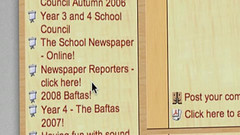What are the ‘functional specifications’ of a VLE that drive real learning?
You may want to read my post What is a VLE? as an introduction to this post!
 It’s the nature of blogs that they reflect the ideas and interests of those who write them. As a consequence, this particular one has, of late, featured much on the ‘nuts and bolts’ of E-Learning – i.e. the systems and processes that enable Virtual Learning Environments (VLEs), for example, to work effectively.
It’s the nature of blogs that they reflect the ideas and interests of those who write them. As a consequence, this particular one has, of late, featured much on the ‘nuts and bolts’ of E-Learning – i.e. the systems and processes that enable Virtual Learning Environments (VLEs), for example, to work effectively.
In my new role as Director of E-Learning (and I quote from my job description) it is my responsibility to:
Ensure the creation of the virtual learning environment (VLE), identifying clear targets, time-scales and success criteria for its development and maintenance in line with the Academy Development plan.
As such, in conjunction with the ICT Advisor from the Academy’s consultants, I need to come up with some ‘functional specifications’ for the VLE. We shall be using the existing VLE that is in place in the current High school, either developing that or replacing it for the new build in 2011.
Becta’s list of functional requirements can be found here, but I wanted to ask those in my network if they had any other suggestions. Here’s what they came up with in a short space of time (click to enlarge):
In terms of what I want to see in a VLE, I think it needs to:
- Be a collaborative space where students and staff can collaborate on documents and web pages (like Google Apps)
- Enable users to have appropriate contact with others within the Academy and the wider community by a range of methods (e.g. Twitter-like microblogging, instant messaging, shared whitetboards, video conferencing,email, social networking)
- Promote learning by have clearly structured course elements, rather than be a file repository.
- Process appropriate data quickly in a visually-appealing and easy-to-understand way for Academy staff, students, and parents.
- Allow students to publish their work to various parties: peers, teachers, the Academy, the world.
- Enable outside agencies to access appropriate data on students, staff and Academy issues.
- OpenID login so users have a single sign-on and have more control over their digital identity.
- Integration with immersive worlds such as Second Life (as, for example Sloodle does)
I’m sure by 2011 there will be many other things I want the VLE to do function-wise, but that’s enough for now… Would appreciate your input in the comments section! 😀
(image by Mr Ush @ Flickr)


Doug, you may want to take a look at some of the things from HE for this, for example:
http://www.jiscinfonet.ac.uk/InfoKits/effective-use-of-VLEs
I would say the absolute base has got to be that it allows for users (espec. staff) to easily produce and publish content for learners even if they have no confidence in their IT skills.
It should also allow for publishing of both public and private content as appropriate with ‘course’ or other structures to allow for granularity in privileges and access.
Thanks Ian – I’ll take a look! :-)
Hi Doug
There is lots to discuss in this post. In fact maybe too much. Might make an excellent basis for a discussion at http://edtechroundup.com.
One of the things that strikes me is the publishing of pupil work to the world. A must to open up different audiences to our learners; that is a significant factor for pushing online work in classrooms. So, that said, how do we protect their identity? Should we? Or should we protect them from unwanted interest and teach them to keep specific details (e.g. email address) secret outside the school community?
At the moment, I am also thinking that VLEs should not be a file repository (no surprise there, but this is the easy self-explanatory hook for new teachers) but then the question is what do you mean by *clearly structured course elements*? What is your ideal? What would you like to see happening across the academy in 2015? Teachers (all?) using the VLE to present various learning opportunities: aggregating tools, learning progress and outcomes.
My thoughts on this (the ideal) to apply to my current model is that every unit of work delivered in my school would have a master template course on the VLE. That means a teacher would accept that, for any unit on our school curriculum, there must be a course to contain a bank of resources for teaching and learning (lesson plans, IWB pages, links, suggested forums, suggested assignments and much more). This would form the starting point for any learning unit. Any teacher would be free to use it as they deemed appropriate, but also be able to add/remove items for their class. The tools may be dictated by the individual teacher and possibly the pupils; add wikis, assignments, forums, workshops etc. to generate the dynamic learning process. All this is possible on Moodle and, I imagine, many other LPs.
The problem is defining your expectations and then making it part of the Headteachers expectations of his/her teaching staff. Maybe it is necessary to forge that vision together, as a whole staff body. Ambitious but possible. You might have the opportunity to do that over two academic years.
Thanks for sharing the ‘nuts and bolts’ of E-Learning. Its’ really helpful for a learner.
No problem – glad to be of help! :-)